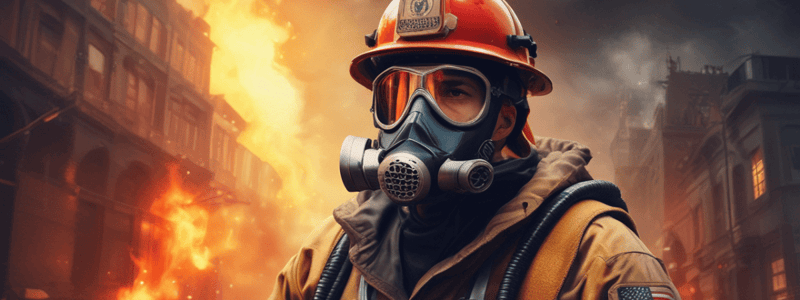Podcast
Questions and Answers
How long must records of medical evaluations and fit testing results be retained?
How long must records of medical evaluations and fit testing results be retained?
- Until the employee is no longer required to wear a respirator
- For at least 5 years (correct)
- For the duration of the employee's tenure
- For at least 3 years
What is the primary purpose of consulting employees on respirator use?
What is the primary purpose of consulting employees on respirator use?
- To discipline employees who fail to wear respirators properly
- To determine the most cost-effective respirator option
- To evaluate the effectiveness of the respirator program (correct)
- To ensure compliance with OSHA regulations
What document must be made available to affected employees and the Administration or designee for examination and copying?
What document must be made available to affected employees and the Administration or designee for examination and copying?
- Employee training records
- Fit testing results
- The written respiratory protection program (correct)
- Medical evaluation records
What is an important factor to consider when selecting a respirator for an employee?
What is an important factor to consider when selecting a respirator for an employee?
What is the purpose of conducting evaluations of the workplace?
What is the purpose of conducting evaluations of the workplace?
What is an important aspect of proper respirator use?
What is an important aspect of proper respirator use?
What is the primary objective of the Respirator Guidelines?
What is the primary objective of the Respirator Guidelines?
Which approach is preferred when feasible, prior to utilizing respirators?
Which approach is preferred when feasible, prior to utilizing respirators?
Who is responsible for overseeing the Respirator Program?
Who is responsible for overseeing the Respirator Program?
When should respirators be used according to the guidelines?
When should respirators be used according to the guidelines?
What date is set for the re-evaluation of the Respirator Guidelines?
What date is set for the re-evaluation of the Respirator Guidelines?
What must be adhered to while using respirators according to the guidelines?
What must be adhered to while using respirators according to the guidelines?
What do accepted engineering controls include?
What do accepted engineering controls include?
What is a necessary action when engineering controls are not feasible?
What is a necessary action when engineering controls are not feasible?
Which of the following is NOT a component that should be inspected during a monthly respirator inspection?
Which of the following is NOT a component that should be inspected during a monthly respirator inspection?
What is the minimum pressure at which air or oxygen cylinders must be refilled?
What is the minimum pressure at which air or oxygen cylinders must be refilled?
Which of the following components can ONLY be adjusted and repaired by the manufacturer or a manufacturer-trained technician?
Which of the following components can ONLY be adjusted and repaired by the manufacturer or a manufacturer-trained technician?
What type of compressed air must be used for respirators, according to the text?
What type of compressed air must be used for respirators, according to the text?
Which of the following statements about the inspection of elastomeric parts is TRUE?
Which of the following statements about the inspection of elastomeric parts is TRUE?
According to the content, which of the following is NOT a requirement for respirators that fail an inspection?
According to the content, which of the following is NOT a requirement for respirators that fail an inspection?
What is the minimum frequency of inspection for all emergency respirators?
What is the minimum frequency of inspection for all emergency respirators?
Which of the following statements about the inspection of SCBA and SAR units is TRUE?
Which of the following statements about the inspection of SCBA and SAR units is TRUE?
Under what circumstances are additional fit tests required for employees wearing respirators?
Under what circumstances are additional fit tests required for employees wearing respirators?
What must happen if an employee develops an unacceptable respirator fit after passing a QLFT or QNFT?
What must happen if an employee develops an unacceptable respirator fit after passing a QLFT or QNFT?
Which of the following fit test methods is only applicable to negative pressure air-purifying respirators with a fit factor of 100 or less?
Which of the following fit test methods is only applicable to negative pressure air-purifying respirators with a fit factor of 100 or less?
What type of respirator requires a QNFT for tight-fitting half-face pieces with a fit factor equal to or greater than 100?
What type of respirator requires a QNFT for tight-fitting half-face pieces with a fit factor equal to or greater than 100?
How must atmosphere-supplying and powered air-purifying respirators be fit-tested?
How must atmosphere-supplying and powered air-purifying respirators be fit-tested?
What is the minimum fit factor required for a tight-fitting full-face piece to be fit-tested using QNFT?
What is the minimum fit factor required for a tight-fitting full-face piece to be fit-tested using QNFT?
Which of the following is NOT a permissible condition for wearing a tight-fitting face piece?
Which of the following is NOT a permissible condition for wearing a tight-fitting face piece?
What is the purpose of modifying the face piece for QNFT on atmosphere-supplying and powered air-purifying respirators?
What is the purpose of modifying the face piece for QNFT on atmosphere-supplying and powered air-purifying respirators?
Which of the following must be part of a respiratory protection program for employees using respirators?
Which of the following must be part of a respiratory protection program for employees using respirators?
What should be done if the employee's exposure to respiratory hazards cannot be reasonably estimated?
What should be done if the employee's exposure to respiratory hazards cannot be reasonably estimated?
Which type of respirator is required for IDLH atmospheres?
Which type of respirator is required for IDLH atmospheres?
When selecting respirators for non-IDLH atmospheres, which of the following considerations is necessary?
When selecting respirators for non-IDLH atmospheres, which of the following considerations is necessary?
What is necessary if air-purifying respirators are used in the workplace?
What is necessary if air-purifying respirators are used in the workplace?
Which criteria must be evaluated when selecting respirators based on respiratory hazards?
Which criteria must be evaluated when selecting respirators based on respiratory hazards?
For which situations must respiratory protection be provided to employees?
For which situations must respiratory protection be provided to employees?
What is a critical component in the selection of respirators to ensure proper fit?
What is a critical component in the selection of respirators to ensure proper fit?
Study Notes
Purpose and Objectives
- Control occupational diseases caused by breathing contaminated air
- Primary objectives: prevent atmospheric contamination
- Use accepted engineering control measures (enclosure, ventilation, substitution of less toxic materials)
Policy
- Use respirators when engineering controls are not feasible or while they are being instituted
- Respirators shall be used only during designated activities
- Respirator Program Administrator (Battalion Chief of Training and Safety) develops and implements a written respiratory protection program
Program Components
A. Selection of Respirators
- General requirements:
- Respirator selection based on respiratory hazards
- Use only NIOSH-approved respirators
- Identify and evaluate respiratory hazards in the workplace
- Select respirators in sufficient models and sizes to fit users correctly
- Respirators for IDLH atmospheres:
- Full face piece pressure demand SCBA or combination full face piece pressure demand SAR with auxiliary self-contained air supply
- All oxygen-deficient atmospheres considered IDLH
- Respirators for non-IDLH atmospheres:
- Provide a respirator that protects employees and meets OSHA requirements
- Selection based on chemical state and physical form of contaminant
- Use air-purifying respirators with end-of-service-life indicator (ESLI) or filter change schedule
Fit Testing
- Fit tests administered using OSHA-accepted QLFT or QNFT protocol
- QLFT only for negative pressure air-purifying respirators with a fit factor of 100 or less
- QNFT for tight-fitting half face pieces or tight-fitting full face pieces
- Fit testing for tight-fitting atmosphere-supplying and tight-fitting powered air purifying respirators must be completed in negative pressure mode
Use of Respirators
- Employees must not wear tight-fitting face pieces under certain conditions
- Inspect emergency respirators at least monthly
- Ensure respirator inspection includes function, connection tightness, and condition of parts
- SCBA and SAR units must be inspected monthly
- Air and oxygen cylinders must be maintained as fully charged and refilled at 90% of manufacturer's recommended pressure
Breathing Air Quality and Use
- Compressed air, compressed oxygen, liquid air, and liquid oxygen used for respirators must meet Pharmacopoeia requirements for medical or breathing oxygen
- Compressed air must be at least Type 1-Grade D breathing air according to ANSI/Compressed Gas Association Commodity Specification for Air
Recordkeeping
- Retain records of medical evaluations and fit testing results for at least 5 years
- Retain written copy of current respiratory protection program and all previous programs covering previous 5 years
- Make retained written materials available upon request to affected employees and Administration or designee for examination and copying
Studying That Suits You
Use AI to generate personalized quizzes and flashcards to suit your learning preferences.
Related Documents
Description
Learn about the standard operating guidelines for fire department respirator use, NIMS compliant and effective from January 1, 2022.




